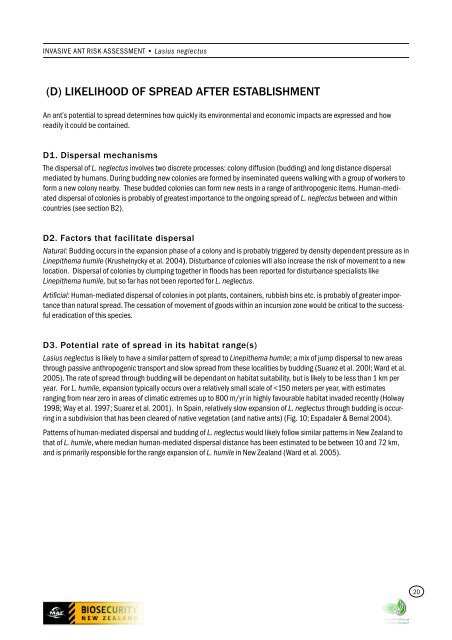Lasius neglectus (A) PEST INFORMATION - Biosecurity New Zealand
Lasius neglectus (A) PEST INFORMATION - Biosecurity New Zealand
Lasius neglectus (A) PEST INFORMATION - Biosecurity New Zealand
Create successful ePaper yourself
Turn your PDF publications into a flip-book with our unique Google optimized e-Paper software.
INVASIVE ANT RISK ASSESSMENT • <strong>Lasius</strong> <strong>neglectus</strong><br />
(D) LIKELIHOOD OF SPREAD AFTER ESTABLISHMENT<br />
An ant’s potential to spread determines how quickly its environmental and economic impacts are expressed and how<br />
readily it could be contained.<br />
D1. Dispersal mechanisms<br />
The dispersal of L. <strong>neglectus</strong> involves two discrete processes: colony diffusion (budding) and long distance dispersal<br />
mediated by humans. During budding new colonies are formed by inseminated queens walking with a group of workers to<br />
form a new colony nearby. These budded colonies can form new nests in a range of anthropogenic items. Human-mediated<br />
dispersal of colonies is probably of greatest importance to the ongoing spread of L. <strong>neglectus</strong> between and within<br />
countries (see section B2).<br />
D2. Factors that facilitate dispersal<br />
Natural: Budding occurs in the expansion phase of a colony and is probably triggered by density dependent pressure as in<br />
Linepithema humile (Krushelnycky et al. 2004). Disturbance of colonies will also increase the risk of movement to a new<br />
location. Dispersal of colonies by clumping together in floods has been reported for disturbance specialists like<br />
Linepithema humile, but so far has not been reported for L. <strong>neglectus</strong>.<br />
Artificial: Human-mediated dispersal of colonies in pot plants, containers, rubbish bins etc. is probably of greater importance<br />
than natural spread. The cessation of movement of goods within an incursion zone would be critical to the successful<br />
eradication of this species.<br />
D3. Potential rate of spread in its habitat range(s)<br />
<strong>Lasius</strong> <strong>neglectus</strong> is likely to have a similar pattern of spread to Linepithema humile; a mix of jump dispersal to new areas<br />
through passive anthropogenic transport and slow spread from these localities by budding (Suarez et al. 200l; Ward et al.<br />
2005). The rate of spread through budding will be dependant on habitat suitability, but is likely to be less than 1 km per<br />
year. For L. humile, expansion typically occurs over a relatively small scale of
















